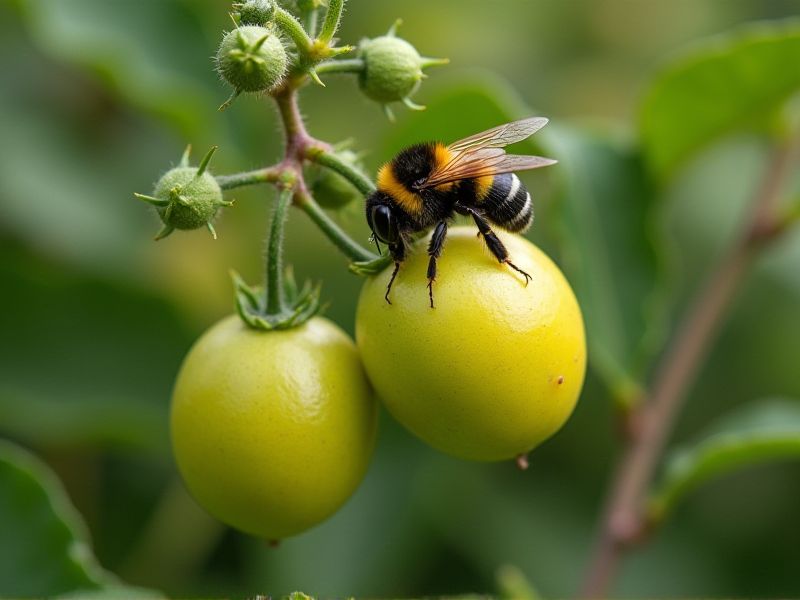
Many fruit plants thrive on cross-pollination, which enhances their fruit production and genetic diversity. For instance, apple trees (Malus domestica) depend on pollen from different apple varieties to yield a successful harvest. Blueberries (Vaccinium spp.) benefit significantly from cross-pollination, resulting in larger and more abundant berries. Cherry trees (Prunus avium), particularly sweet varieties, require pollen from another cultivar for optimal fruit set. To maximize your garden's yield, consider planting compatible varieties of these fruits nearby to facilitate effective cross-pollination.
List of some Fruit plants that require cross-pollination
- Apple (Malus domestica)
- Pear (Pyrus communis)
- Plum (Prunus domestica)
- Sweet Cherry (Prunus avium)
- Kiwi (Actinidia deliciosa)
- Blueberry (Vaccinium corymbosum)
- Persimmon (Diospyros kaki)
- Hazelnut (Corylus avellana)
- Jujube (Ziziphus jujuba)
- Chestnut (Castanea sativa)
Important things about Fruit plants that require cross-pollination
Increased Fruit Yield
Certain fruit plants, such as apples, cherries, and blueberries, require cross-pollination to achieve maximum fruit yield. These plants produce flowers with both male and female reproductive organs but often depend on pollen transfer from other compatible varieties to fertilize their ovules effectively. By planting at least two different cultivars nearby, you enhance the chances of successful pollination, which leads to larger and more abundant fruit production. Local pollinators, such as bees and butterflies, play a crucial role in this process, making the conservation of these insects vital for your garden's productivity.
Genetic Diversity Promotion
Fruit plants such as strawberries, kiwis, and apples thrive on cross-pollination, which enhances genetic diversity and improves fruit quality. By cultivating multiple varieties of these species in your garden, you can encourage beneficial interactions among pollinators like bees and butterflies, ultimately leading to higher fruit yields. Cross-pollination not only boosts resistance to diseases but also results in more robust and flavorful produce. Engaging with local nurseries to acquire diverse cultivar selections will significantly contribute to the genetic health of your fruit plants.
Specific Pollinator Attraction
Fruit plants such as blueberries, cherries, and apples often require cross-pollination to set fruit successfully, making them reliant on specific pollinators like bees and butterflies. These plants produce distinct flowers that attract pollinators through vibrant colors and sweet fragrances, which signal the availability of nectar and pollen. As these pollinators move from one plant to another, they facilitate genetic diversity and enhance fruit yield, crucial for healthy harvests. You can maximize your fruit production by planting compatible varieties nearby to support your local pollinator population and ensure effective cross-pollination.
Flower Structure Compatibility
Many fruit plants rely on cross-pollination due to their floral structure, which enhances genetic diversity and increases fruit yield. For example, apple trees exhibit perfect flowers, but they often require pollen from a different variety to produce fruit successfully. Similarly, strawberries, with their unique blossom morphology, benefit significantly from external pollinators like bees, which transfer pollen between different plants. Understanding the compatibility of flower structures among various fruit species is crucial for gardeners and farmers aiming to optimize their harvest.
Cross-Pollination Timing
Cross-pollination in fruit plants is crucial for enhancing fruit quality and yield, with species like apples, cherries, and blueberries being prime examples. Understanding the timing of flowering is essential, as these plants often have specific blooming periods that must coincide for effective pollination. To optimize yields, it's advisable to plant compatible varieties that flower simultaneously, maximizing the chances of pollen transfer by insects or wind. Monitoring local climate conditions can also inform the best time to plant these species, ensuring their pollination windows align perfectly with your gardening goals.
Pollination Methods
Fruit plants that require cross-pollination depend on the transfer of pollen between different varieties to produce fruit. Examples include apples, blueberries, and almonds, which rely on insects, wind, or birds to facilitate this process. You can enhance fruit yield and quality by planting compatible varieties nearby to attract pollinators, ensuring effective pollen transfer. This method not only boosts your harvest but also supports local ecosystems by promoting biodiversity among flowering plants.
Neighboring Compatible Varieties
Many fruit plants thrive through cross-pollination, which enhances fruit quality and yield. Apple trees, for example, require compatible neighboring varieties such as 'Granny Smith' and 'Fuji' to increase pollen transfer and fertilization. Similarly, pears benefit from pairing with another variety like 'Bartlett' to ensure optimal pollination. Planting these compatible fruit trees within proximity helps maximize your harvest while supporting biodiversity in your garden.
Pollinator Habitat Preservation
Fruit plants such as apples, pears, and almonds thrive through cross-pollination, relying heavily on pollinators like bees and butterflies to transfer pollen between blossoms. Preserving pollinator habitats is crucial for ensuring the health and productivity of these fruit crops, as a diverse ecosystem supports the pollinators' survival and seasonal activity. Planting native flowers and maintaining unfragmented green spaces increase the abundance of these vital insects, enhancing your fruit harvest. By fostering a pollinator-friendly environment in your garden, you can improve biodiversity while ensuring a bountiful yield from your cross-pollinating fruit plants.
Weather Impact On Pollination
Weather significantly influences the pollination process in fruit plants that necessitate cross-pollination, such as apple and cherry trees. Optimal temperatures and controlled humidity are essential for bees and other pollinators, as extreme weather conditions can disrupt their activity, leading to reduced fruit yields. Rain and strong winds during the flowering period may hinder pollinator access, impacting the transfer of pollen between blossoms. Consequently, ensuring a stable and favorable weather environment is crucial for enhancing successful fruit set and maximizing crop productivity for these plants.
Importance Of Planting Multiples
Planting multiple fruit plants that require cross-pollination is essential for ensuring higher fruit yields and better fruit quality. Certain varieties, such as apple, cherry, and pear trees, depend on pollen from different cultivars to facilitate fertilization and fruit set. By incorporating diverse plant species within your garden, you enhance genetic diversity, which can lead to improved disease resistance and adaptability to environmental changes. Furthermore, attracting pollinators becomes more effective with multiple flowering plants, creating a thriving ecosystem that benefits both your fruit production and local biodiversity.
